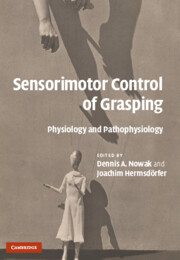Book contents
- Frontmatter
- Contents
- List of contributors
- Preface
- Part I Methodology
- Part II The physiology of grasping
- 10 The study of hand movements during grasping. A historical perspective
- 11 Sensory control of object manipulation
- 12 Predictive mechanisms and object representations used in object manipulation
- 13 The neurohaptic control of the hand
- 14 Points for precision grip
- 15 Two hands in object-oriented action
- 16 Dynamic grasp control during gait
- 17 Development of grasping and object manipulation
- 18 The effects of aging on sensorimotor control of the hand
- Part III The pathophysiology of grasping
- Part IV Therapy of impaired grasping
- Index
- Plate section
- References
14 - Points for precision grip
Published online by Cambridge University Press: 23 December 2009
- Frontmatter
- Contents
- List of contributors
- Preface
- Part I Methodology
- Part II The physiology of grasping
- 10 The study of hand movements during grasping. A historical perspective
- 11 Sensory control of object manipulation
- 12 Predictive mechanisms and object representations used in object manipulation
- 13 The neurohaptic control of the hand
- 14 Points for precision grip
- 15 Two hands in object-oriented action
- 16 Dynamic grasp control during gait
- 17 Development of grasping and object manipulation
- 18 The effects of aging on sensorimotor control of the hand
- Part III The pathophysiology of grasping
- Part IV Therapy of impaired grasping
- Index
- Plate section
- References
Summary
Summary
We describe constraints on grip points in reaching and lifting objects. Most objects afford a choice of points providing stable grip with thumb and index finger. We overview experiments showing how micro (surface texture determining friction) and macro (local shape for determining direction of the surface normal relative to interdigit force, and global shape for determining center of mass) geometric features affect precision grip. We summarize the roles of visual and haptic cues in selection of grip points and describe how planning takes account not only of the object but also the intended action in directing grasp to these points. We support our arguments with evidence taken from studies of normal and disordered motor behavior.
Introduction
In characterizing the sensorimotor control of grasping, other chapters in this book have emphasized coordination between the hand, which shapes to and grasps the object, and the arm, which moves the hand to the object and lifts both hand and object through space (Jones & Lederman, 2006; see also Chapters 1, 11–13). Generally, the object concerned has been provided with vertical and parallel sides, the grasp has been a precision grip, and the goal of the action has been to maintain a stable grip so that the object neither translates nor rotates relative to the hand.
- Type
- Chapter
- Information
- Sensorimotor Control of GraspingPhysiology and Pathophysiology, pp. 193 - 203Publisher: Cambridge University PressPrint publication year: 2009
References
- 4
- Cited by

